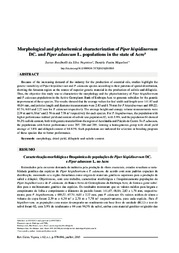Morphological and phytochemical characterization of Piper hispidinervum DC. and Piper aduncum L. populations in the state of Acre.
Morphological and phytochemical characterization of Piper hispidinervum DC. and Piper aduncum L. populations in the state of Acre.
Autoria: NEGREIROS, J. R. da S.; NIQUELONI, D. P.
Resumo: Because of the increasing demand of the industry for the production of essential oils, studies highlight the genetic variability of Piper hispidinervum and P. aduncum species according to their patterns of spatial distribution, showing the Amazon region as the source of superior genetic material in the production of safrole and dillapiole. Thus, the objective this study was to characterize the morphology and the phytochemistry of Piper hispidinervum and P. aduncum populations in the Active Germplasm Bank of Embrapa Acre to generate subsidies for the genetic improvement of these species. The results showed that the average values for leaf width and length were 141.67 and 48.04 mm, and petioles length and diameter measurements were 2.83 and 1.78 mm for P. hispidinervum and 189.22; 67.74; 6.03 and 2.22 mm for P. aduncum respectively. The average height and canopy volume measurements were 2.39 m and 6.30 m3 and 2.70 m and 7.78 m3 respectively for each species. For P. hispidinervum, the population with higher performance indried yield and content of safrole was population 02, with 3.9%, and the population 04 showed 94.3% safrole content, both with genetic material from the region of Acrelândia and Plácido de Castro. To P. aduncum, the populations with better performance were 207, 208 and 209, forming a homogeneous group with dried yield average of 3.8% and dillapiol content of 84-85%. Such populations are indicated for selection in breeding program of these species due to better performance.
Ano de publicação: 2015
Tipo de publicação: Artigo de periódico
Unidade: Embrapa Acre
Palavras-chave: Aceites esenciales, Acre, Amazonia Occidental, Amazônia Ocidental, Banco de Germoplasma, Biogeografia, Biogeography, Dilapidol, Dilapiol, Embrapa Acre, Essential oils, Fitomejoramiento, Genetic variation, Melhoramento genético vegetal, Morfologia vegetal, Morfología de las plantas, Physicochemical properties, Pimenta de macaco, Pimenta longa, Piper aduncum, Piper hispidinervum, Piper longum, Plant breeding, Plant morphology, Propiedades fisicoquímicas, Propriedade físico-química, Rio Branco (AC), Safrol, Safrole, Variación genética, Variação genética, Western Amazon, Óleo essencial
Observações
1 - Por padrão são exibidas publicações dos últimos 20 anos. Para encontrar publicações mais antigas, configure o filtro ano de publicação, colocando o ano a partir do qual você deseja encontrar publicações. O filtro está na coluna da esquerda na busca acima.
2 - Para ler algumas publicações da Embrapa (apenas as que estão em formato ePub), é necessário ter, no celular ou computador, um desses softwares gratuitos. Sistemas Android: Google Play Livros; IOS: iBooks; Windows e Linux: software Calibre.
Acesse outras publicações
Acesse a Base de Dados da Pesquisa Agropecuária (BDPA) para consultar o acervo completo das bibliotecas da Embrapa.

